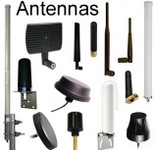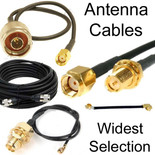Technical Support for Antennas & Related Gear
MIMO: Multiple In / Multiple Out Technology in 802.11ac and 802.11n
Multiple In / Multiple Out (MIMO):

MIMO technology: By overlaying the signals of multiple radios, Wireless-N's "Multiple In, Multiple Out" (MIMO) technology multiplies the effective data rate. Unlike ordinary wireless networking technologies confused by signal reflections, MIMO uses these reflections to increase the range and reduce "dead spots" in the wireless coverage area. The robust signal travels farther, maintaining wireless connections up to 4 times farther than standard Wireless-G.
Multiple-input and multiple-output, or MIMO (pronounced mee-moh or mai-moh), is a powerful technology that uses multiple antennas at the transmitter and receiver to enhance the performance of radio communication systems. It is a form of 'Smart antenna' technology at the forefront of wireless research. MIMO technology significantly boosts data throughput and link range without requiring additional bandwidth or transmit power. This is achieved through higher spectral efficiency (more bits per second per Hertz of bandwidth) and improved link reliability or diversity (reduced fading). These impressive properties make MIMO a key focus of international wireless research antennas at the transmitter and receiver to improve the performance of radio communication systems. It is one of several forms of "Smart antenna" (SA) in a narrow sense or the state of the art of SA technology. MIMO technology significantly increases data throughput and link range without additional bandwidth or transmit power. It achieves this by higher spectral efficiency (more bits per second per Hertz of bandwidth) and link reliability or diversity (reduced fading). Because of these properties, MIMO is currently a central theme of international wireless research (2007).
MIMO antennas: MIMO uses multiple transmitter and receiver antennas to allow for increased data throughput via spatial multiplexing and increased range by exploiting the spatial diversity, perhaps through coding schemes like Alamouti coding. Antenna are listed in a format of 2x2 for two receivers and two transmitters. A 4x4 is four receivers and four transmitters. The number of antennae relates to the number of simultaneous streams. The standard requirement is a 2x2 with two streams. The standard does optionally allow for the potential of a 4x4 with four streams.
Deployment: A pure 802.11n 5 GHz network is recommended for optimal performance. The 5 GHz band offers substantial capacity with many non-overlapping radio channels and less radio interference than the 2.4 GHz band. However, transitioning to an 802.11n-only network may not be feasible for many users due to the prevalence of 802.11b/g-only devices. Replacing incompatible WiFi cards or entire laptop stock is necessary in such cases. To facilitate a smoother transition, it may be more practical in the short term to operate a mixed 802.11b/g/n network until 802.11n hardware becomes more prevalent. In a mixed-mode system, it's generally best to use a dual-radio access point and allocate the 802.11b/g traffic to the 2.4 GHz radio. The 802.11n traffic to the GHz band has substantial capacity due to many non-overlapping radio channels and less radio interference than the 2.4 GHz band. An 802.11n-only network may be impractical for many users because the existing computer stock is predominantly 802.11b/g only. Replacement of incompatible WiFi cards or entire laptop stock is necessary for older computers to operate on the network. Therefore, it may be more practical in the short term to manage a mixed 802.11b/g/n network until 802.11n hardware becomes more prevalent. In a mixed-mode system, it's generally best to use a dual-radio access point and place the 802.11b/g traffic on the 2.4 GHz radio and the 802.11n traffic on the 5 GHz radio.







